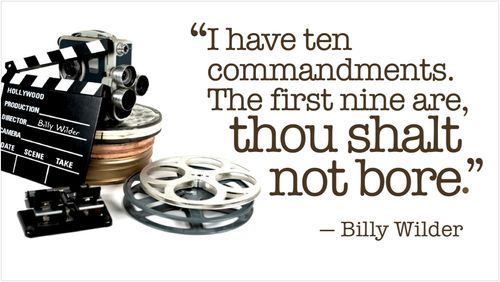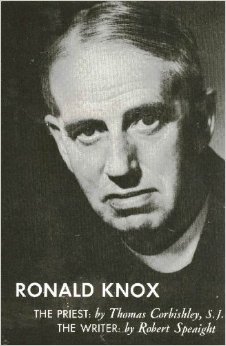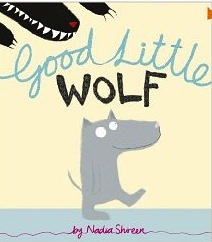Jennifer Crusie's Blog, page 243
January 11, 2016
Fruitcake Humor is Hard
A couple of weeks ago, I went looking for a picture for the Cherry Saturday fruitcake post and found Frank the Fruitcake. He was part of a Walmart “Humorous” Share-This-Video meme-creating advertising plan:
I figure they handed this to some guy and said, “Do funny fruitcake videos but keep it PG,” and the poor sod got drunk and banged out these truly lame and definitely not funny mini-vids. I felt nothing but scorn. (I was not alone in this.)
But then today I began thinking about humor. Humor and fruitcake. You’d think that would be a natural and yet . . . no. I tried, but mine were as bad as the poor sod’s. Even going dark doesn’t help.

Fruitcake Humor is hard. No really, you try it.
The post Fruitcake Humor is Hard appeared first on Argh Ink.

January 10, 2016
Translating Wilder: Ten Rules of Good Screenwriting
From the Argh Draft Vault, dated Dec. 23, 2013, but updated and finished today:
I just found Billy Wilder’s famous ten rules of good filmmaking, and they translate pretty well to novel writing. Well, I can translate them into novel-writing. I don’t agree with the first one, but I think that might be semantics; the rest are absolutely applicable. So here are Wilder’s rules and my translations into novel speak:
1: The audience is fickle.
I don’t think readers are fickle: if you deliver good story, they’ll come back. But I do think that most readers want their favorite writers to keep writing the same story, the one they like, and they’ll leave the writer who doesn’t do that. I understand this, I don’t read anything by Dick Francis that doesn’t have horses and death in it, but it is frustrating for writers who have other stories to tell.
2: Grab ‘em by the throat and never let ‘em go.
Yep. Start your story (which is your conflict) on the first page and keep building it until it’s resolved on the last page (which is the end of your conflict). Don’t mosey.
3: Develop a clean line of action for your leading character.
Character is action. Your character has a goal she desperately needs. She goes after it deliberately and logically with no veering off course. If you garbage up her line of action with extraneous stuff, you obscure your story.
4: Know where you’re going.
Always know the ending before you start. If possible, know the climactic scene before you start. If you don’t know where you’re going, you won’t be able to figure out how to get there.
5: The more subtle and elegant you are in hiding your plot points, the better you are as a writer.
I’m not clear what Wilder means here. If he’s saying “Don’t announce what each move means,” then I’m with him. But I do think there has to be a clear plot through line that the reader can follow without a problem I’m pretty sure that’s he says in #3 above. So I’m going to go with, “Avoid on-the-nose and as-you-know dialogue and never explain what things mean; your reader is not stupid.”
6: If you have a problem with the third act, the real problem is in the first act.
Or, “If your ending sucks, it’s because you blew the beginning.”
This is one of the many reasons you write the first scene last (or at least rewrite it last): the beginning sets up the ending by promising the reader that THIS is what the story is about, this outrage, this injustice, this danger to someone we care about. If you make that promise in the beginning and invest the reader in the outcome of that promise, you then know that you have to fulfill that promise at the end.
7: A tip from Lubitsch: Let the audience add up two plus two. They’ll love you forever.
Never talk down to your readers, never assume they’re too dumb to get what you’re doing. You’re partners in this story, they help you write it as they read it, so treat them as equals or better.

8: In doing voice-overs, be careful not to describe what the audience already sees. Add to what they’re seeing.
We don’t do voiceovers in fiction, we do internal monologue, and we’re a lot less likely to describe the action because we’re a lot less likely to write the action. So for fiction, I’d reverse this to “In doing internal monologue, be careful to keep the bodies in motion on the page, characters in action as the POV character thinks. The actions should be in contrast to the internal thoughts, not just the illustration of what the POV character is thinking.”
9: The event that occurs at the second act curtain triggers the end of the movie.
The end of the second act in movie-making is the Crisis or dark moment . . .
10: The third act must build, build, build in tempo and action until the last event, and then — that’s it. Don’t hang around.
Absolutely. Once your protagonist is stable again, get the hell out. Your story is over.
Oh, and this, in spades:

The post Translating Wilder: Ten Rules of Good Screenwriting appeared first on Argh Ink.

January 9, 2016
Cherry Saturday: 1-9-2016
Today is Play God(dess) Day. Or as I call it, “writing a novel.”

You are omnipotent. What would you do today?
(Note: Never google for “goddess.” You get a bunch of blonde Barbies in white nightgowns. It’s depressing.)

The post Cherry Saturday: 1-9-2016 appeared first on Argh Ink.

January 8, 2016
Rules for Golden Age Mystery Writing: Thank God It’s Not 1928 Anymore
Welcome to a post from the Argh Draft Vault. This was saved as a draft on Dec. 18, 2013, and I’ve rewritten it to post now due to popular demand. (Well, a couple of you asked for a mystery post.) I was struggling with You Again when I first wrote this, my version of a Golden Age mystery (a bunch of people trapped in a house, people start dying, you know that one), so I looked at the classic rule lists from S.S. Van Dine, Ronald Knox, the Detection Club, and Raymond Chandler. Chandler’s list is solid. Everybody else? Thank god it’s not 1928 anymore, especially if you were a servant, Chinese, or twins. Here’s the post; it’s 6400 words long, mostly because Van Dine is wordy, so get a cup of a tea and cookie, this is going to take awhile:
About ten years ago [now twelve], I started a book called You Again, my homage to Golden Age mysteries, in spite of the fact that I am lousy at writing mysteries. Since then, that damn book has been sitting on my shoulder like Poe’s raven, croaking, “Neverdone” at me, so I’m taking another shot at it. This time, though, I’m looking more closely at my source material, especially the Golden Age Mystery rules, some of which are helpful and some of which are appalling. (S. S. Van Dine is not somebody I’d have lunch with.) Below are four different mystery rule lists with my comments, followed by own list (because everybody wants to know what a non-mystery writer thinks about writing mysteries).

S.S.VAN DINE’s RULES FROM 1928:
S. S. Van Dine (aka Willard Huntington Wright) wrote the Philo Vance mysteries:
“I might have been a bit presumptuous, y’know,” said Vance, “but when the lady was extolling the deceased’s popularity, I rather thought she was overdoing it a bit. There was an unconscious implication of antithesis in her eulogy, which suggested to me that she herself was not ardently enamored of the gentleman.”
“And what put the notion of firearms into your mind?”
“That query,” explained Vance, “was a corollary of your own question about barred windows and Benson’s fear of burglars. If he was in a funk about housebreakers or enemies, would he be likely to have firearms at hand–eh, what?”
The Benson Murder Case
Yeah, Philo has not worn well. Here are van Dine’s rules:
1. The reader must have equal opportunity with the detective for solving the mystery. All clues must be plainly stated and described.
I think this is a basic. Part of the fun of the mystery is the puzzle, and the reader should have all the pieces. It’s okay to disguise them but not to omit them.
2. No wilful tricks or deceptions may be played on the reader other than those played legitimately by the criminal on the detective himself.
This is something I’m rabid about: no gotchas. The reader has to be able to trust the writer; lying to her or tricking her is a cheat that destroys that trust.
3. There must be no love interest in the story. To introduce amour is to clutter up a purely intellectual experience with irrelevant sentiment. The business in hand is to bring a criminal to the bar of justice, not to bring a lovelorn couple to the hymeneal altar.
Oh, please. Romance is to mystery what peanut butter is to chocolate. I’m good with barring the “hymeneal altar” though; that sounds gross.
4. The detective himself, or one of the official investigators, should never turn out to be the culprit. This is bald trickery, on a par with offering some one a bright penny for a five-dollar gold piece. It’s false pretenses.
I think in general this is good, but I wouldn’t set it in stone. Christie did this well, even if she did outrage a nation. The real problem is the POV violation; the reader needs to know what the POV character knows.
5. The culprit must be determined by logical deductions–not by accident or coincidence or unmotivated confession. To solve a criminal problem in this latter fashion is like sending the reader on a deliberate wild-goose chase, and then telling him, after he has failed, that you had the object of his search up your sleeve all the time. Such an author is no better than a practical joker.
See #2, the “No Gotchas” rule.
6. The detective novel must have a detective in it; and a detective is not a detective unless he detects. His function is to gather clues that will eventually lead to the person who did the dirty work in the first chapter; and if the detective does not reach his conclusions through an analysis of those clues, he has no more solved his problem than the schoolboy who gets his answer out of the back of the arithmetic.
This seems obvious. A mystery must have a detective who detects in the same way that a romance must have lovers who love. Since our respect for the detective depends on how well she detects, she better be aces with clues and analysis.
7. There simply must be a corpse in a detective novel, and the deader the corpse the better. No lesser crime than murder will suffice. Three hundred pages is far too much pother for a crime other than murder. After all, the reader’s trouble and expenditure of energy must be rewarded. Americans are essentially humane, and therefore a tiptop murder arouses their sense of vengeance and horror. They wish to bring the perpetrator to justice; and when “murder most foul, as in the best it is,” has been committed, the chase is on with all the righteous enthusiasm of which the thrice gentle reader is capable.
Setting aside the “Americans are generally humane” bit (I think that can be called into question both globally and nationally), I think we’re into semantics here. There can be detectives in ghost stories, detectives in capers, but if we’re talking about murder mysteries, then yes, there has to be a murder, or at least an inconvenient accident that people then commit crimes to cover up. Let’s say “serious, community threatening crime” which includes murder.
8. The problem of the crime must be solved by strictly naturalistic means. Such methods for learning the truth as slate-writing, ouija-boards, mind-reading, spiritualistic sÈances, crystal-gazing, and the like, are taboo. A reader has a chance when matching his wits with a rationalistic detective, but if he must compete with the world of spirits and go chasing about the fourth dimension of metaphysics, he is defeated ab initio.
This is one I’m going to violate because You Again has ghosts (and Alice and Isolde) so they’re actually characters in the story. I’m not about to bar the supernatural; it’s too much fun. But it can’t provide the solution; that has to come from the detective’s analysis.
9.There must be but one detective–that is, but one protagonist of deduction–one deus ex machine. To bring the minds of three or four, or sometimes a gang of detectives to bear on a problem is not only to disperse the interest and break the direct thread of logic, but to take an unfair advantage of the reader, who, at the outset, pits his mind against that of the detective and proceeds to do mental battle. If there is more than one detective the reader doesn’t know who his co-deductor is. It’s like making the reader run a race with a relay team.
Again, I think this is too reductive. One protagonist, yes, and that protagonist is probably the detective, but the role of community in modern storytelling is too important to ignore. The key here is that there’s one character the reader attaches to, and that character is the reader’s partner in the game. All the other characters who are helping bring the aid to both of them, so the story is still focused.
10. The culprit must turn out to be a person who has played a more or less prominent part in the story–that is, a person with whom the reader is familiar and in whom he takes an interest. For a writer to fasten the crime, in the final chapter, on a stranger or person who has played a wholly unimportant part in the tale, is to confess to his inability to match wits with the reader.
I think this is crucial. If you think about it, a murder is a crime against community, creating a wound, a crack in that world, not just because the people in it have lost a piece of their group, but also because there’s a murderer among them, so they draw away from each other, poisoned by suspicion and fear. They can’t reform as a group until the toxin is removed by the identification and punishment of the killer. If the criminal isn’t one of them, the threat becomes random and bogus, and the story loses its center.
11. Servants–such as butlers, footmen, valets, game-keepers, cooks, and the like–must not be chosen by the author as the culprit. This is begging a noble question. It is a too easy solution. It is unsatisfactory, and makes the reader feel that his time has been wasted. The culprit must be a decidedly worth-while person–one that wouldn’t ordinarily come under suspicion; for if the crime was the sordid work of a menial, the author would have had no business to embalm it in book-form.
S.S.Van Dine, elitist prig. “You know what I hate? Murder by menial. It’s so distasteful, unlike the classy defenestrations done by the upper class.”
12. There must be but one culprit, no matter how many murders are committed. The culprit may, of course, have a minor helper or co-plotter; but the entire onus must rest on one pair of shoulders: the entire indignation of the reader must be permitted to concentrate on a single black nature.
I’m with him on this one: one antagonist. Focus your conflict, people.
13. Secret societies, camorras, mafias, et al., have no place in a detective story. Here the author gets into adventure fiction and secret-service romance. A fascinating and truly beautiful murder is irremediably spoiled by any such wholesale culpability. To be sure, the murderer in a detective novel should be given a sporting chance, but it is going too far to grant him a secret society (with its ubiquitous havens, mass protection, etc.) to fall back on. No high-class, self-respecting murderer would want such odds in his jousting-bout with the police.
“No high-class, self-respecting murderer . . .” S.S., are you even listening to yourself? Jesus.
14. The method of murder, and the means of detecting it, must be rational and scientific. That is to say, pseudo-science and purely imaginative and speculative devices are not to be tolerated in the roman policier. For instance, the murder of a victim by a newly found element–a super-radium, let us say–is not a legitimate problem. Nor may a rare and unknown drug, which has its existence only in the author’s imagination, be administered. A detective-story writer must limit himself, toxicologically speaking, to the pharmacopoeia. Once an author soars into the realm of fantasy, in the Jules Verne manner, he is outside the bounds of detective fiction, cavorting in the uncharted reaches of adventure.
I think this is just an extension of the no-gotcha, play-fair rule. Unless you’ve set up the method thoroughly so it’s part of the plot, just poison the suckers with cyanide or push them down elevator shafts. Much less explaining to do.
15. The truth of the problem must at all times be apparent–provided the reader is shrewd enough to see it. By this I mean that if the reader, after learning the explanation for the crime, should reread the book, he would see that the solution had, in a sense, been staring him in the face–that all the clues really pointed to the culprit–and that, if he had been as clever as the detective, he could have solved the mystery himself without going on to the final chapter. That the clever reader does often thus solve the problem goes without saying. And one of my basic theories of detective fiction is that, if a detective story is fairly and legitimately constructed, it is impossible to keep the solution from all readers. There will inevitably be a certain number of them just as shrewd as the author; and if the author has shown the proper sportsmanship and honesty in his statement and projection of the crime and its clues, these perspicacious readers will be able, by analysis, elimination and logic, to put their finger on the culprit as soon as the detective does. And herein lies the zest of the game. Herein we have an explanation for the fact that readers who would spurn the ordinary “popular” novel will read detective stories unblushingly.
This is the hardest part of writing ANYTHING: fulfill expectations while surprising the reader so that the second time she reads the story, it’s all brand new. Having said that, S.S.’s assumption that the ordinary popular novel makes reader blush is another brick in the wall of his delusions of superiority. After all, this is the guy who wrote Philo Vance, the character Raymond Chandler called “the most asinine character in detective fiction.” Or as Ogden Nash put it, “Philo Vance/Needs a kick in the pants.” As does S. S.
16. A detective novel should contain no long descriptive passages, no literary dallying with side-issues, no subtly worked-out character analyses, no “atmospheric” preoccupations. Such matters have no vital place in a record of crime and deduction. They hold up the action, and introduce issues irrelevant to the main purpose, which is to state a problem, analyze it, and bring it to a successful conclusion. To be sure, there must be a sufficient descriptiveness and character delineation to give the novel verisimilitude; but when an author of a detective story has reached that literary point where he has created a gripping sense of reality and enlisted the reader’s interest and sympathy in the characters and the problem, he has gone as far in the purely “literary” technique as is legitimate and compatible with the needs of a criminal-problem document. A detective story is a grim business, and the reader goes to it, not for literary furbelows and style and beautiful descriptions and the projection of moods, but for mental stimulation and intellectual activity–just as he goes to a ball game or to a cross-word puzzle. Lectures between innings at the Polo Grounds on the beauties of nature would scarcely enhance the interest in the struggle between two contesting baseball nines; and dissertations on etymology and orthography interspersed in the definitions of a cross-word puzzle would tend only to irritate the solver bent on making the words interlock correctly.
I agree with this in general, although I think the most interesting part of this (and several of his other rules) is the idea that the mystery novel is a game, a puzzle, instead of a story first and foremost. I realize that Golden Age mysteries were often read that way, but the ones that have lasted (and the Philo Vance mysteries have not) are the ones where their writers took storytelling and character development seriously. But yes, keep your eyes on the prize: less “it was a dark and stormy night” and more “she shoved her mother off the widow’s walk.”
17. A professional criminal must never be shouldered with the guilt of a crime in a detective story. Crimes by house-breakers and bandits are the province of the police department–not of authors and brilliant amateur detectives. Such crimes belong to the routine work of the Homicide Bureaus. A really fascinating crime is one committed by a pillar of a church, or a spinster noted for her charities.
I think he’s just phrased this wrong. It should be, “The murderer should be an important character in the book, not somebody who just stopped by for a bash.” I think “the least likely suspect” is an outdated approach, although still better than “the most likely suspect.” Also outdated: the idea that the detective must be an amateur, showing up the plodding professional constabulary.
18. A crime in a detective story must never turn out to be an accident or a suicide. To end an odyssey of sleuthing with such an anti-climax is to play an unpardonable trick on the reader. If a book-buyer should demand his two dollars back on the ground that the crime was a fake, any court with a sense of justice would decide in his favor and add a stinging reprimand to the author who thus hoodwinked a trusting and kind-hearted reader.
Two dollars. Those were the days. I think today you can get by with an accident or a suicide if it pushes other characters into illegalities to cover it up, such as the Reginald Hill mystery where the victim died by accident and then others made it look like murder for financial gain. The real problem with an accidental death is that there’s no antagonist: if nobody’s committed a crime, there’s no opposite number for the detective.
19. The motives for all crimes in detective stories should be personal. International plottings and war politics belong in a different category of fiction–in secret-service tales, for instance. But a murder story must be kept gemütlich, so to speak. It must reflect the reader’s everyday experiences, and give him a certain outlet for his own repressed desires and emotions.
I think motives should always be personal, but then I think all motives are. [“Gemütlich” here seems to translate to “cosy” or “relatable;” the cosy mystery as opposed to the thriller or gritty police procedural.)
20. And (to give my Credo an even score of items) I herewith list a few of the devices which no self-respecting detective-story writer will now avail himself of. They have been employed too often, and are familiar to all true lovers of literary crime. To use them is a confession of the author’s ineptitude and lack of originality.
Determining the identity of the culprit by comparing the butt of a cigarette left at the scene of the crime with the brand smoked by a suspect.
S.S. would freak at CSI.
The bogus spiritualistic sÈance to frighten the culprit into giving himself away.
That is cheesy.
Forged finger-prints.
They did that on White Collar and again on Limitless, and it was brilliant. Wrong again, S. S.
The dummy-figure alibi.
I think this is where people think they’re watching the suspect but actually he’s put a dummy in his chair to give himself an alibi. My question is, “This works?”
The dog that does not bark and thereby reveals the fact that the intruder is familiar.
Do not fuck with Sherlock Holmes, S.S.
The final pinning of the crime on a twin, or a relative who looks exactly like the suspected, but innocent, person.
Now I have a burning desire to write twins.
The hypodermic syringe and the knockout drops.
Why? They work.
The commission of the murder in a locked room after the police have actually broken in.
I love that one. Stop being such a pooper, S. S.
The word-association test for guilt.
This works? More important, how would you get that into evidence? “Your honor, I said ‘scarlet’ and she said ‘I killed him in the library with the lead pipe.'”
The cipher, or code letter, which is eventually unravelled by the sleuth.
I love a good code. At this point, he’s just being arbitrary. So the hell with S S Van Dine, let’s move on to . . .

RONALD KNOX’S DECALOGUE FROM 1929
So S. S. Van Dine was a putz. Ronald Knox’s list a year later is better, as is his fiction (although Knox has that turn-of-the-last-century racism thing undercutting him):
“You see,” put in Gordon,”the detectives in the book always have such luck. The murderer generally has a wooden leg, and that doesn’t take much detecting. The trouble in real life is the way murderers go about unamputated. And then there’s the left-handed men, how conveniently they come in! I tried detection once on a old pipe, and I can show you from the way the side of it was charred that the owner was right-handed. But there are so many right-handed people.”
“In most cases,” said Carmichael,”it’s only nerves that make people think they’re left-handed.”
The Viaduct Murder
Here are Knox’s rules:
1. The criminal must be mentioned in the early part of the story, but must not be anyone whose thoughts the reader has been allowed to know.
Again, POV. If you’re in the criminal’s POV, you know what he or she is thinking, and it’s a cheat if the reader doesn’t know it, too. Unless you’re Agatha Christie.
2. All supernatural or preternatural agencies are ruled out as a matter of course.
I like ghosts.
3. Not more than one secret room or passage is allowable.
A Clue game has four secret passages, but I can see where after one, you’d call in a building inspector and find a floor plan.
4. No hitherto undiscovered poisons may be used, nor any appliance which will need a long scientific explanation at the end.
I agree: go with sharp shoves or a nice common poison. Otherwise you have all that damn exposition to deal with.
5. No Chinaman must figure in the story.
Ronald Knox: Racist. Okay, what he really means is don’t use cliches (evidently there were a lot of murderous Chinese littering the corridors of Golden Age detective fiction which is just odd), but still, racist.
6. No accident must ever help the detective, nor must he ever have an unaccountable intuition which proves to be right.
That’s just basic storytelling; no deus ex machina, including unsupported insights.
7. The detective himself must not commit the crime.
Agatha Christie begs to differ, but it is a POV problem.
8. The detective is bound to declare any clues which he may discover.
This is basic third limited POV: If you’re in the protagonist’s point of view, you have to see what she sees. I do object to “declare.” The detective can keep her mouth shut, the writer just has to make sure the reader knows what she knows.
9. The “sidekick” of the detective, the Watson, must not conceal from the reader any thoughts which pass through his mind: his intelligence must be slightly, but very slightly, below that of the average reader.
Who is this average reader of whom you speak? And why does the BFF have to be slightly below average? Okay, the Watson is usually the stand-in for the reader, the guy/girl on the street, and if he or she is a POV character we’re back to the reader knowing what he or she knows. I think this is just POV.
10. Twin brothers, and doubles generally, must not appear unless we have been duly prepared for them.
And now I must write twins. (Did you see that Grimm episode that had quadruplets? Knox would have had fits.)
And then there’s
The Detection Club
“The Detection Club was formed in 1930 by a group of British mystery writers, including Agatha Christie, Dorothy L. Sayers, Ronald Knox, Freeman Wills Crofts, Arthur Morrison, John Rhode, Jessie Rickard, Baroness Emma Orczy, R. Austin Freeman, G. D. H. Cole, Margaret Cole, E. C. Bentley, Henry Wade, and H. C. Bailey. Anthony Berkeley was instrumental in setting up the club, and the first president was G. K. Chesterton. There was a fanciful initiation ritual with an oath probably written by either Chesterton or Sayers, and the club held regular dinner meetings in London.”
From Wikipedia

RULES OF FAIR PLAY from THE DETECTION CLUB, 1930
These are the rules that Christie, Sayers, Chesterton and the others cobbled together at a dinner one night in 1930, probably in an attempt to clean up after Van Dine and Knox.
1. The criminal must be someone mentioned in the early part of the story, but must not be anyone whose thoughts the reader has been allowed to follow.
Get that antagonist out there and working for you early. However, I don’t think the crime has to be committed in the first pages. Just get the whole cast on stage as soon as possible.
2. All supernatural or preternatural agencies are ruled out as a matter of course. To solve a detective problem by such means would be like winning a race on the river by the use of a concealed motor-engine.
Again with the “no ghosts” thing. I think they’re objecting to a deus ex machina more than ghosts.
3. Not more than one secret room or passage is allowable.
That’s it. I’m putting in a secret passage.
4. No hitherto undiscovered poisons may be used, nor any appliance which will need a long scientific explanation at the end.
Really so much simpler for everybody if the murderer just shoves somebody off something high.
5. No Chinaman must figure in the story.
Again, I think this means “Avoid cliches,” but it’s still racist as all hell.
6. No accident must ever help the detective, nor must he ever have an unaccountable intuition which proves to be right.
I’d change that to “any protagonist in any story after the first page,” but yep.
7. The detective must not himself commit the crime.
This was four years after Christie did that. I wonder if they shouted her down, or if she just laughed and showed them her royalty statements.
8. The detective must not light on any clues are not instantly produced for the inspection of the reader.
POV again, plus fair play.
9. The stupid friend of the detective, the Watson, must not conceal any thoughts which pass through his mind; his intelligence must be slightly, but very slightly, below that of the average reader.
No on the dumbed-down Watsons; they’re a lot more fun if they’re smart. See Lucy Liu’s Watson on Sherlock, James Hathaway on Lewis, and Dalziel in the Hill mysteries. The “must not be concealed” is POV again.
10. Twin brothers, and doubles generally, must not appear unless we have been duly prepared for them.
I’m definitely writing twins.
And just for fun, here’s the oath taken by all members of the Detection Club:
“Do you promise that your detectives shall well and truly detect the crimes presented to them using those wits which it may please you to bestow upon them and not placing reliance on nor making use of Divine Revelation, Feminine Intuition, Mumbo Jumbo, Jiggery-Pokery, Coincidence, or Act of God? “
I don’t know what Jiggery-Pokery is, but I’m going to place some reliance on it. Plus feminine intuition is just paying attention to people, including menials and Chinamen. :p
And finally we have the Big Kahuna of Noir, Raymond Chandler:

“Tall, aren’t you?” she said.
“I didn’t mean to be.”
Her eyes rounded. She was puzzled. She was thinking. I could see, even on that short acquaintance, that thinking was always going to be a bother to her.
“Handsome, too,” she said. “And I bet you know it.”
I grunted.
“What’s your name?”
“Reilly, I said. “Doghouse Reilly.”
“That’s a funny name.” She bit her lip, and turned her head a little, and looked at me along her eyes. Then she lowered her lashes until they almost cuddled her cheeks and slowly raised them again, like a theater curtain. I was to get to know that trick. That was supposed to make me roll over on my back with all four paws in the air.
The Big Sleep
RAYMOND CHANDLER’S TEN COMMANDMENTS FOR THE DETECTIVE NOVEL
1. [The story] must be credibly motivated, both as to the original situation and the dénouement.
This is just good characterization.
2. It must be technically sound as to the methods of murder and detection.
This speaks to the reader’s trust in the writer, the idea that there is an intelligent authority in the text.
3. It must be realistic in character, setting and atmosphere. It must be about real people in a real world.
Chandler wrote noir, and it would be hard to find a more stylized and constructed world than the mean streets his detectives walked down, but I think the key here is that once you’ve constructed your world and introduced it to the reader, it has to stay internally consistent. If your world has vampires in it, then that’s the realism of that world. So maybe rewrite this one as, “Don’t violate the integrity of your story world.”
4. It must have a sound story value apart from the mystery element: i.e., the investigation itself must be an adventure worth reading.
This is where I started to love Chandler. A puzzle is not a story. There has to be a ride in there, a conflict that swoops and escalates and takes the reader with it. A mystery is first and foremost a story; the puzzle is just part of the structure.
5. It must have enough essential simplicity to be explained easily when the time comes.
“You’re probably wondering why I called you all together . . .” The best mystery endings are simple, the final piece falling into place and revealing the whole without explanation.
6. It must baffle a reasonably intelligent reader.
Never dumb down. I never do because I always assume my reader is smarter than I am, but in general, construct a mystery that’s complex enough to be baffling and at the same time rational and logical enough to come together easily in the reader’s mind when it’s revealed.
7. The solution must seem inevitable once revealed.
This is so crucial in any story, I think. You want the final reversal to surprise expectation, and leave the reader saying, “Of course, this couldn’t happen any other way.” This, by the way, is damn hard.
8. It must not try to do everything at once. If it is a puzzle story operating in a rather cool, reasonable atmosphere, it cannot also be a violent adventure or a passionate romance.
Pick a lane. It isn’t that you can’t have a romance in a mystery novel, it’s that you have to decide if it’s a mystery with a romance subplot or a romance with a mystery subplot.
9. It must punish the criminal in one way or another, not necessarily by operation of the law….If the detective fails to resolve the consequences of the crime, the story is an unresolved chord and leaves irritation behind it.
This goes back to catharsis. A story almost always begins with a stable world being jarred into instability through injustice of some kind, and the ensuing plot is the protagonist’s attempts to restore that justice. In a mystery, it’s pretty clear cut: somebody’s committed a crime against society by murdering one of its members, and that person must be caught and brought to justice before the social order can be restored and the community returned to stability. No punishment for the crime, no justice, no stability, no catharsis.
10. It must be honest with the reader.
Never lie to your reader. Ever. She’ll never trust you again.
And just to make things fair, here’s my two cents:

Sophie Dempsey didn’t like Temptation even before the Garveys smashed into her ’86 Civic, broke her sister’s sunglasses, and confirmed all her worst suspicions about people from small towns who drove beige Cadillacs.
CRUSIE’S SUGGESTIONS FOR WRITING GOLDEN AGE MYSTERIES
(I don’t do rules. Tools maybe. Really more guidelines. Suggestions. Oh, hell, do what you want. It’s your story.)
(Also keep in mind: I’m a lousy mystery writer. So you know, grain of salt.)
CHARACTER
1. Get your detective on the first page. The corpse can come later, but you want your reader attaching to her partner in solving the puzzle right off the bat.
2. Establish your detective’s skills and personality through action, not through statements from her or other people about her. Character is action, first and foremost; it’s a lot more fun to watch somebody being clever than to be told she’s clever.
3. Establish your murderer’s skills through the clues that show his or her actions; your reader needs to know that Our Detective is up against somebody smart and ruthless, if possible smarter and more ruthless than she is.
4. One of the keys to any mystery lies in the character of the victim (unless the crime was random, in which case, good luck plotting that sucker). Therefore the character of the victim must be established through his or her actions or words or the words of those who knew him or her. The one exception is the mystery in which the identity of the victim is unknown, but that never lasts long.
5. The detective must have a good reason for pursuing the case, especially if he or she is not a professional. That reason almost always comes from character: because she is the kind of person she is, she takes the murder personally and must act.
6. Those three characters form the triumvirate of your story: The victim whose character causes him or her to move into the path of the murderer, the murderer whose character causes him or her to commit the worst crime known to humanity, and the detective whose character causes him or her to implacably hunt down and defeat the murderer. Understanding the relationships among these three will help focus your plot.
PLOT
7. The discovery of each clue should move the plot forward, with crucial clues a major factor in the turning points. That is, as the story escalates, so should the clues, revealing deeper levels of the puzzle (“This is not as simple as we thought!”) and greater danger, especially as the clues move the detective closer to the murderer.
8. The clues and the characters’ reactions to the discovery of the clues should reveal not only the character of the murderer, but also the characters of everyone affected by the murder. If possible, the discovery of the identity of the killer should mean different things to the different major characters, so each clue should spur each of them to a different reaction and possibly a different course of action.
9. The macguffin in a murder mystery is the identity of the killer; a corollary to that is the discovery of evidence to convict the killer. The reason most detectives in murder mysteries follow a trail of clues to the murderer’s identity instead of discovering the identity and then trying to find proof is that the reveal is generally the climactic moment. It’s convenient (but not mandatory) if the final clue to the killer’s identity and the final piece of evidence that will convict him or her is one and the same.
10. The clues have to be on the page. The reader must know everything the POV character knows. No gotchas. However, the meanings of these clues and this knowledge don’t have to be spelled out or even emphasized. A mystery writer is like a magician, directing the reader’s attention elsewhere while pulling the rabbit out of the hat without concealing the existence of the rabbit or the hat.
11. Any subplot such as a love story must be integral to the mystery, complicating and echoing the main plot. One of the reasons mystery and romance go so well together is that they’re both dangerous premises that involve discovering the true identity of someone who has disrupted the status quo. Find the parallels to your main plot in your subplots and make the same scenes work for both of them to keep your story focused.
12. Remember that all your characters know that there’s a murderer loose. The person who wanders about the garden alone at midnight had better be meeting somebody vital or he or she is Too Stupid To Live. Ditto for the detective who takes time off to flirt while the bodies pile up.
13. Once the final mystery is over (usually the identity of the murderer), the story is over; any denouement should be brief and mainly deal with the return of the story world to stability.
WORLD
14. Get your entire cast introduced in the first quarter of the book, including and especially the murderer. This is the society the murderer transgresses against, so merely describing the environment won’t do it; setting is people, too.
15: Henry James, author of that great country house story The Turn of the Screw, said “Plot is characters under stress.” The tighter and more claustrophobic the story world is, the more stress its characters are under. This is one of the reasons the country house cut off from the rest of the world is such an attractive setting. A story world that is “modern America” is too broad to create the kind of focused tension you want in mystery. Narrow it to the confines of a workplace, a family, a neighborhood, a small town, that isolated country house; the smaller the world, the greater the transgression of the crime and the stronger the need to re-establish stability. (See also, “Ark Movie” from the Ebert List of Movie Terms.)
16: Establish the hierarchy within the world that the detective will have to navigate. Who has the power to stop the investigation or block paths of inquiry? Who blusters, who manipulates, who plots, who lies, who weeps? In the context of worldbuilding, think of characters as barriers or gateways in the maze of the plot
17. Establish how this world works. A character who refuses to give information might be seen as an enemy unless she’s part of a world that bars medical practitioners from divulging anything about their patients; a medical practitioner who volunteers to divulge confidential information about a patient in that world might be seen as suspicious and untrustworthy. What are this world’s rules, spoken and unspoken?
18. A detective is traditionally an outsider, entering a world to restore stability. But because she’s an outsider, her entry into that world creates more instability. How does your detective interact with that world? Does she stand apart and observe or is she drawn into it? How is her investigation hampered by not being part of that world? How is it hampered if she’s drawn into it?
19. Never forget that you’re telling a story first and solving a puzzle second. A coherent story world filled with well-developed characters trumps a fiendishly clever puzzle every time. Better yet, write both.
20. Any mystery can be improved by putting twin Chinese housemaids in a secret passage carrying a poison unknown to man with the recipe for the antidote written in code by a ghost. Also, up yours, S.S. Van Dine.
And now, over to you, Argh People. Anybody have a rule/suggestion/guideline that Van Dine, Knox, the Detection Club, Chandler, and I missed? Have at it in the comments.
The post Rules for Golden Age Mystery Writing: Thank God It’s Not 1928 Anymore appeared first on Argh Ink.

January 7, 2016
Random Sunday
Another blast from the Argh Draft Vault, this one from April 21, 2010. Greets!
I love the things Google does with logos. One of my faves, this one for National Radio Day:
So steampunk.
Speaking of steampunk, I crave this Steampunk Desktop

If I could figure out how to do it, I’d make one myself.
Hmmmmm.
Sometimes my spam cracks me up. We got this one on PopD:
Hi buddy, your blog’s design is simple and clean and i like it. Your blog posts are superb. Please keep them coming. Greets!!!
Now I want to say “Greets!!!” to everybody.
A big thanks to that yahoo who married a pillow because now Sweetness is planning on marrying her computer. She said, “I can do that, right?” I said, “No. You can’t marry things.” She looked at the dachshund in her lap and said, “Okay, then I’ll marry Milton.” I said, “Nope, can’t marry dogs.” “Why not?” I opened my mouth and then thought, Why the hell can’t you marry dogs? I mean, I know you can’t, but why? I finally said, “Informed consent. You have to be an adult and be able to consent to the contract. That’s why kids can’t can’t marry.” Sweetness nodded and said, ‘Yeah, dogs can’t say ‘I do.'” Now I’m waiting for the note from the teacher asking me to come in to discuss the whole informed-consent-marrying dogs thing.
Another great spam:
Genial brief and this enter helped me alot in my college assignement. Gratefulness you as your information.
It’s like haiku. With an ulterior motive.
Speaking of Sweetness, remember Prancer? The reindeer snuff film? They made a stuffed animal:
It’s for sale on Amazon (as Red Holly Reindeer from Skelanimals), but you have to be careful online. For example, on April Fool’s Day, Gamestation added a clause to their terms-of-usage that most people (including me) automatically accept without reading:
By placing an order via this Web site on the first day of the fourth month of the year 2010 Anno Domini, you agree to grant Us a non transferable option to claim, for now and for ever more, your immortal soul. Should We wish to exercise this option, you agree to surrender your immortal soul, and any claim you may have on it, within 5 (five) working days of receiving written notification from gamesation.co.uk or one of its duly authorized minions.
Yeah. They claimed your immortal soul. Then they sent out e-mails saying, “Nah, we don’t want your soul after all,” so the souls are all safe, but the fictional possibilities of this are very tempting. (They also rewarded the people who read the thing and declined, so I love these people.)
But really, Kharos would be all over this.
When the kids screw up and it’s not bad enough to yell at them, we tell them they’re going to Hell’s Hamster Wheel, so when I found this video, I sent it to them so they could see their futures:
Except I put the wrong address in the “To” field and Sarah at Smart Bitches got it. And now Sarah is throwing up because I gave her vertigo. Do I know how to network or what?
(Note: The link was gone and I have NO idea what video I sent Sarah. So I found another one. Now I want hamsters. There’s a Hamster Wheel Greatest Hits video here.)
More spam with a personal touch:
Dear admin, thnx for sharing this blog post. I found it wonderful. Best regards, Victoria…
Thnx back at you, Vicky.
No, really, I appreciate politeness. And I’m trying to instill this in Sweetness and Light. For example, we were in the car (me in the front, Sweetness and Light in the back seat), and the woman in front me stopped suddenly. I slammed on the brakes.
FAJ: What the f– . . . really-bad-word are you doing, lady?
Light: I know what you were going to say.
FAJ: DON’T SAY IT. Ever. It’s bad.
Light: Freaking.
FAJ: Oh. You can say that.
Light: Or fuck.
Speaking of f-words, I freaking love the Sony Bravia commercials, especially the one with the exploding paint.
They’re all on You Tube, and along with them are the Making-Of videos.
Here’s the Bravia Bunnies:
But really, watch them all. Dominos in India and thread in Egypt and balls in San Francisco and definitely paint in Glasgow, plus the making-of videos for them. Just wonderful.
Or Eye Candy which is Weirdness in Color, but that parrot is worth it all.
And until we meet again, greets!!!
The post Random Sunday appeared first on Argh Ink.

January 6, 2016
A Rant About Endings
Another blast from the Argh Draft Vault:
I have been thinking about endings lately because I saw a TV movie and read a children’s book, both of which had endings that were horribly wrong, not because they didn’t turn out the way I expected but because they didn’t fit their stories. I think that endings, both in story and in life, have to make sense because otherwise they really don’t end, they lurk in the background while your subconscious tries to find the justice in them, like trying to get a popcorn kernel out of the back molar of your brain.
The thing is, stories determine their own endings. The way the story is told, the way a life is lived, pretty much sets up the big finish. You can’t slap a happy ending on a story that didn’t deserve it because it makes the whole story a lie, and you can’t put a tragic ending on a story to make it more important because that betrays the story itself. If a story has earned a happy ending, give it to it, don’t sell it down the river for literary cred or worse, cool, ironic detachment.
Warning: Spoilers ahead. Big ones.
THE THIRTY-NINE STEPS The first bad ending was in the 2008 remake of The 39 Steps. I’m a huge fan of Hitchcock’s 1935 version of Buchan’s book, but I was open to a new interpretation and it was fun for the most part even if it did take unnecessary liberties. There was a dashing hero, feisty heroine, evil villains, great cars . . . what’s not to love? Richard Hannay is given a code book by a spy who is then murdered, and the killers (German spies before WW1) frame Richard for the crime. He goes on the run to Scotland because that’s where the German spy ring is, trying to decode the book as he goes so he can find them and expose them, ducking the police and the Germans and most of Scotland on the way. Once there he meets Victoria, an out-spoken feminist/activist, and they do the requisite wrangling as they fall in love while stealing cars and blowing up oubliettes. It’s not deep or historically accurate, but it’s fun, albeit leisurely fun, made more fun because it turns out Victoria is a British spy and a dab hand with a revolver among other skills.
The first bad ending was in the 2008 remake of The 39 Steps. I’m a huge fan of Hitchcock’s 1935 version of Buchan’s book, but I was open to a new interpretation and it was fun for the most part even if it did take unnecessary liberties. There was a dashing hero, feisty heroine, evil villains, great cars . . . what’s not to love? Richard Hannay is given a code book by a spy who is then murdered, and the killers (German spies before WW1) frame Richard for the crime. He goes on the run to Scotland because that’s where the German spy ring is, trying to decode the book as he goes so he can find them and expose them, ducking the police and the Germans and most of Scotland on the way. Once there he meets Victoria, an out-spoken feminist/activist, and they do the requisite wrangling as they fall in love while stealing cars and blowing up oubliettes. It’s not deep or historically accurate, but it’s fun, albeit leisurely fun, made more fun because it turns out Victoria is a British spy and a dab hand with a revolver among other skills.
Okay, BIG ENDING SPOILER HERE.
So they defeat the Germans (yeah, we knew they would) and Richard embraces Victoria and tells her he intends to court her properly when they get back to London and she smiles and then one of the Germans shoots her in the back and she falls into the loch and Richard dives in and goes crazy trying to find her, finally giving up and staring heartbroken out to sea. That’s not the part that made it a wall banger, though. It didn’t make sense at all, but there were large parts of the story that didn’t make sense, so I just thought, “This is a terrible adaptation.”
But no, the next scene/last scene is four months later, WW1 has started, and Richard is in London at the station in uniform, preparing to ship out to a war that’s going to last four years, wipe out most of a generation of young men, and completely change the face of Britain (and everywhere else in the Western world for that matter, but this story is about England), a huge, tragic waste that will undoubtedly make him a different man. He runs into Victoria’s brother, who says, “She wanted to say good-bye” and points across the station to Victoria, standing behind some baggage. Evidently she faked her death for national security and told her brother but not Richard. Because she couldn’t trust the man she loved. But now she can. Or something. Then the brother says, “She’ll see you after the war,” and I’m thinking, “The hell she will, she’s a freaking spy and you’re going into battle and even if you both survive you’re not going to be the same people and also, hello, it’s FOUR FUCKING YEARS.” But Richard smiles and waves and then Victoria disappears again and there’s your happy ending.
This does not makes sense. If it made sense for Victoria to die, I’d have been fine with it. If it was crucial for Victoria to go undercover, I’d have handled it. If the “we’ll meet again” coda had had any validity, I’d have cried and smiled with Richard. But it was just the dumbest writing I’d ever seen on TV (and that’s saying something). I don’t have to have a Happily Ever After, but if I’m staring at the screen saying, “WHAT THE HELL IS THIS CRAP?” the rest of the story is ruined. Even if everything up to there is stellar (it wasn’t), a bad ending is like a bad apple, it spoils the whole lot. (See also the penultimate scene with the princess in Kingsman; thank god for the last scene of Eggsy in the bar.)
THE GOOD LITTLE WOLF Still reeling from that, I picked up my mail the next day and found a book I’d ordered for the grandkids, The Good Little Wolf. I got suckered into this because I loved the illustrations, truly fabulous drawings. It’s about a good little wolf who is always nice to people until he meets a big bad wolf who tells him that he’s doing it wrong. So he tries to be bad, but he’s bad in his own way so he ends up being good anyway. Finally the BBW goes a step too far and tries to eat Grandma, and the good little wolf fights back and saves the day, and then invites the BBW to have tea with him and Grandma to make peace. And the wolf accepts and they have tea and cake. and the good little wolf makes the big bad wolf promise to never eat anybody again. And the big bad wolf promises.
Still reeling from that, I picked up my mail the next day and found a book I’d ordered for the grandkids, The Good Little Wolf. I got suckered into this because I loved the illustrations, truly fabulous drawings. It’s about a good little wolf who is always nice to people until he meets a big bad wolf who tells him that he’s doing it wrong. So he tries to be bad, but he’s bad in his own way so he ends up being good anyway. Finally the BBW goes a step too far and tries to eat Grandma, and the good little wolf fights back and saves the day, and then invites the BBW to have tea with him and Grandma to make peace. And the wolf accepts and they have tea and cake. and the good little wolf makes the big bad wolf promise to never eat anybody again. And the big bad wolf promises.
So I’m thinking, my grandkids are going to love this book. Then I turn the last page which is the Big Bad Wolf, sitting alone at the table with this huge stomach, saying, “I’ll start tomorrow” because he’s just eaten the good little wolf and grandma.
You know, I’m good with irony. I’m great with snark. And I understand that just like the good little wolf couldn’t change to be bad because it was against his nature, so that big bad wolf couldn’t change to be good. I get all that. But I liked that good little wolf, I attached to that good little wolf, and having him die at the end is not okay. Sweet Jesus, DO NOT KILL THE HERO FOR NO DAMN REASON, PEOPLE. I’m sure the author thought she was being clever as all hell, but she violated story. And yes, I know dark stories are good for kids, I read Where the Wild Things Are to Mollie many times, but the point is that good dark stories should still have just endings. Sendak did not kill his hero because his hero had fought the good fight and deserved to sail home. The good little wolf fought the good fight and got eaten because the author thought that was funny. NOT FUNNY.
So the moral is Do Not Fuck With The Ending To Be Clever. It’s not clever, it’s stupid. I’m still annoyed with Susan Isaacs for killing off one of her heroines by having her get hit by a bus at the end of the book because “sometimes people die.” Yes, sometimes people die for no reason in real life, but fiction is supposed to be better than real life, it’s supposed to make sense. The ending is inherent in the story you tell; if you decide to violate that, you’re violating your story which is going to leave your reader sick to her or his stomach and very unlikely to read you again.
Endings: the most important part of the story. If you lose your reader there, she’ll never come back because you don’t deserve her.
The post A Rant About Endings appeared first on Argh Ink.

January 5, 2016
This Post Is A Time Sink
Here’s another blast from the Argh Draft Vault, May 5, 2014. We’re cleaning house, Argh People.
I just wrote most of a post that’s a rant and realized that was probably a bad idea, so I’m letting it simmer for awhile. But in the process, I had to go look up The Evil Overlord List, the classic list of things that a smart person would do if he or she became an Evil Overlord. (My fave: “34. I will not turn into a snake. It never helps.”)
Unfortunately, I looked at the list on TV Tropes. For those of you who have never been to TV Tropes: Run away. Click that link and you’ll disappear for days. You have been warned.
Back to me and the Evil Overlord List. At the bottom was a link (Curse you, TV Tropes!) to the Roger Ebert Glossary of Movie Terms, including such beauties as
Cooter Rule, The: When the young good-looking hero goes back to his boyhood farmhouse, he’ll inevitably have a fight at the dinner table with an older, less attractive brother. The fight is usually about abandoning the farm and “Spitting on Daddy’s memory” or the hero’s annoying use of correct grammar. The hero storms out of the house, and sits down on a fence in the backyard. He is followed by his sweet, long-suffering sister-in-law. She says, “Trap, you’re gonna have to forgive Cooter/Hunter/Trip/Billy Bob. He loves you. He don’t mean nothin’. It’s just his way, is all.”
And of course, the classic
Idiot Plot: Any plot containing problems which would be solved instantly if all of the characters were not idiots.
Okay, I also like his labeling of a subset of the Big Misunderstanding in romance plots:
Inevitable Sister: In any movie where the heroine catches her boyfriend dancing in public with another woman, and makes a big scene, the other woman invariably turns out to be the boyfriend’s sister. Cf. MYSTIC PIZZA, etc.
And then there’s this:
Wunza Movie: Any film using a plot which can be summarized by saying “One’s a…” For example, “One’s a cop. One’s an actor.” Or “One’s a saint. One’s a sinner.”
Really, they’re all good. Go check out the Ebert’s Glossary of Movie Terms, just part of the legacy of a great critic.
The post This Post Is A Time Sink appeared first on Argh Ink.

January 4, 2016
Deal: All the SMP Crusies for Twelve Bucks
Sure Thing told us about this in the comments yesterday:
I had no idea they were doing this, but those are the best books I’ve ever written. Seven books for twelve bucks is a good price, too. Huh.
Oh, and the first structure post is up over at Writing/Romance.
The post Deal: All the SMP Crusies for Twelve Bucks appeared first on Argh Ink.

January 3, 2016
The Nopefish Is Your Friend
This is a post from the Argh Draft Vault. It seemed appropriate for starting a new year.
I’ve been having a fraught time lately. I don’t think that’s correct usage, I think something needs to be “fraught with” something, but lately I’m fraught with everything, so I’m going with “I’m fraught.” I’ve been dealing with things by saying, “No, that is not my problem;” “No, I am not going to worry about anything that hasn’t happened yet;” “No, I am not going to feel guilty about an honest mistake;” “No, I am not going to make myself crazy about this.” Then I just shortened it all to “Nope.” As in:
“OMG my health insurance is screwed up, I’m going to get frantic, angry and depressed.”
Nope.
“The damn bank lied to me. I’m going to get frantic, angry and depressed.”
Nope.
“The fact that my house looks like a landfill means that I’m a horrible and disgusting person, which makes me frantic, angry and depressed.”
Nope.
“I’ll never get through all this work, I’ll never finish a book, I’ll be typing in my grave, oh dear god, I’m frantic, angry and depressed.”
Nope.
Well, you get the drift. To paraphrase Nancy Reagan: “Just say Nope.” (Although some drugs might be good.)
Then I saw this in the comments on io9:

So now my spirt animal is the Nopefish, and my mental vacation spot, aka “happy place,” is Screwthatistan.
After some reflection, I decided that I needed a Nopefish mascot, which could only be my favorite I-hope-to-hell-I-never-see-one-of-these-up-close denizens of our planet, the angler fish. That thing in the picture above is not an angler fish, it’s a goliath tiger fish. It attacks humans and crocodiles. This is an angler fish:
This educational video explains more about the angler fish (mild profanity and fish-on-shrimp violence):
And people think I don’t research.
Also, now I want this lamp:

Or maybe this one:

And definitely this necklace:

Turns out Anglerfish necklaces are pricey. Maybe the Lego Anglerfish:

Or the puppet:

And defnitely the stamp:

Where was I? Oh, right . . .
The Nopefish: It eats your problems for breakfast.

The post The Nopefish Is Your Friend appeared first on Argh Ink.

January 2, 2016
Cherry Saturday 1-2-2016
Today is National Fruitcake Toss Day.

This is Frank the Fruitcake.
The whole toss thing suddenly became less appealing. Much like Frank.
The post Cherry Saturday 1-2-2016 appeared first on Argh Ink.






